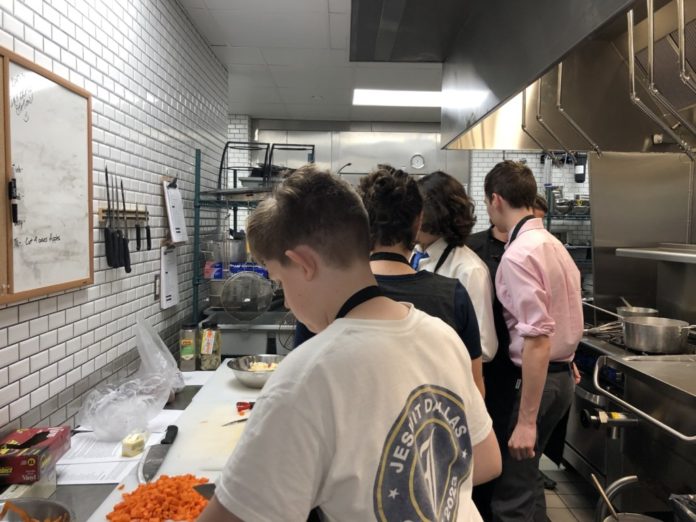Cooking bridges the gap between hunger and satisfaction, making them almost inseparable. Cooking is not always about making dishes to nourish our hungry bodies. It serves as an important facet to a planned, special meal where we can share our lives with others. Every month, a small group of students cultivates the difficult culinary craftsmanship skills that elevate a mere cook to a grand chef. I recently had the chance to catch up with faculty member Mrs. Vollet, as we discussed their last monthly cooking session at the end of September and what ultimately inspired her involvement in the kitchen.
Q: How was September’s meeting? Did you see any progress in people’s cooking skills?
A: We’re kind of all over the place, and there were some guys who I think had ideas about how to cook but had never quite had to manage a whole entire recipe from start to finish. Overall, it was good. For example, we learned a lot of techniques like how to make a béchamel sauce and how to incorporate the cheese so that it didn’t mess up the sauce and make it break. We also talked about the different types of cheeses. There were a lot of different textures, as we used four types: fontina, sharp white cheddar, parmesan, and gruyere.
Q: Is there like anything that you guys are planning on making or planning on doing in the future?
A: I would really like it to be more student-driven and have the guys come up with ideas on what they want to make. We’re going to try to do some breakfast things to accommodate people who have after school practice.
We could do either Belgian waffles and use the waffle makers or demo different ways to cook eggs. It seems like everyone knows one way: their favorite way. They know how to cook how they like their eggs, but not everybody knows how to make them in different styles like over easy, for example.
For over easy, you need to have a really good nonstick pan. “Over easy” is when the yolk is completely runny, and white is lightly cooked on the second side. You want to get it cooked just enough on the bottom so that you can flip it without breaking the yolk. Then, you want to cook it gently on the other side but pull it off before the white gets completely cooked.
Q: How was using Sage’s kitchen? Did they accommodate you guys well?
A: It was really good. It was really interesting. I met with Vinnie beforehand, and we kind of pulled everything out of the kitchen that we knew we would need for Culinary Club, and they had it all set aside for us.
It was kind of cool to use their big industrial gas burners because everything happened faster than it would at home. We discussed about different places where you can cook and kind of what to expect. For instance, if you’re doing this at home, you can expect that it will take more time for the water to boil. If so, you can cut it back for a smaller recipe.
I think the hardest part was getting everything cleaned up at the end. It was just messy everywhere. I think we did a good job keeping it clean. All the steps took longer to do because I was trying to involve people. I would say, “Okay, take a look at the sauce taste it now [and] see if it needs salt. Okay, let’s add this thing to the food.” Then, everybody looked at it and tasted it, so it took a lot longer. The whole process, cooking and cleaning, at home takes a little more than 30 minutes from start to finish. However, with the students, the whole thing is like an hour and a half. So, three times as long to do it in a group.
Q: What are some of the differences in the ingredients used?
A: We used pretty hard cheeses, and we grated them all by hand.
We didn’t do the Velveeta-type macaroni and cheese. These cheeses were all pretty much harder. I think a lot of the guys were surprised by how strong some of them were, like fontina or the gruyere or the different smells they had. The taste didn’t really come through in the sauce once we cooked it.
We used cavatappi pasta, which is very good. It was kind of like macaroni but somewhat different. You can just use straight elbow macaroni. I wanted to use something that was a little fancier.
Q: As a chef, what is your favorite dish to make? How did you get so involved with cooking?
A: The first dish I actually learned to make as a child was boxed mac and cheese, coincidentally. After that, my dad taught me how to boil chicken breasts, and my mom taught me how to make clam chowder. I just kind of went from there. I don’t really have a favorite. I am a very look-at-what-I-have-in-the-pantry-and-figure-out-what-I-can-do-with-it type of person.
I’m not one of those cooks who has staples where Monday is spaghetti night, Tuesday is this, and Wednesday is that. I don’t know that I’ve made a lot of things more than two or three times in total. There’s a really good Indian-like chicken curry that I make. I probably make that one more than anything else.
Q: How did the way you grew up influence your cooking style?
A: So, I grew up in Idaho, but my mom is from Wisconsin, and my dad is from the South. Mostly New Mexico, Texas, and Louisiana, I think he spent most of the time in Louisiana, but strangely my dad doesn’t like grits. He didn’t really do a lot of Southern food. He didn’t make jambalaya or anything like that. I think that coming from my dad’s side, the things that I learned how to make would be pan gravy.
Fried chicken and mashed potatoes, stuff like that, is from my mom’s side. There’s a pretty famous story that my mom cooked once, and then my dad said, “I’ll take care of this.” She made a tuna fish and potato chip casserole, and my dad said, “No thanks. I think I’ll be the cook.”
She would make two things. She makes excellent clam chowder and also this weird thing that’s like minestrone. It’s chili that has noodles in it and vegetables.
It’s good for what it is, but it’s just not really a dish. I don’t know exactly what it’s called, but She just throws a bunch of stuff in a pot and let it sit for a while. She also chops vegetables well to make salads and does all the prep. Plus, she bakes well, so I got my baking from my mom.
Q: What does cooking mean to you?
A: Before I had a child, it could be more leisurely, but it was the way that I liked to cook.
As a parent, I view cooking more as feeding my family. I ask myself, “What are we going to eat for breakfast?” The kids gotta eat, so that is where my main focus is.
Stay tuned to The Roundup for more coverage of the Culinary Society!






